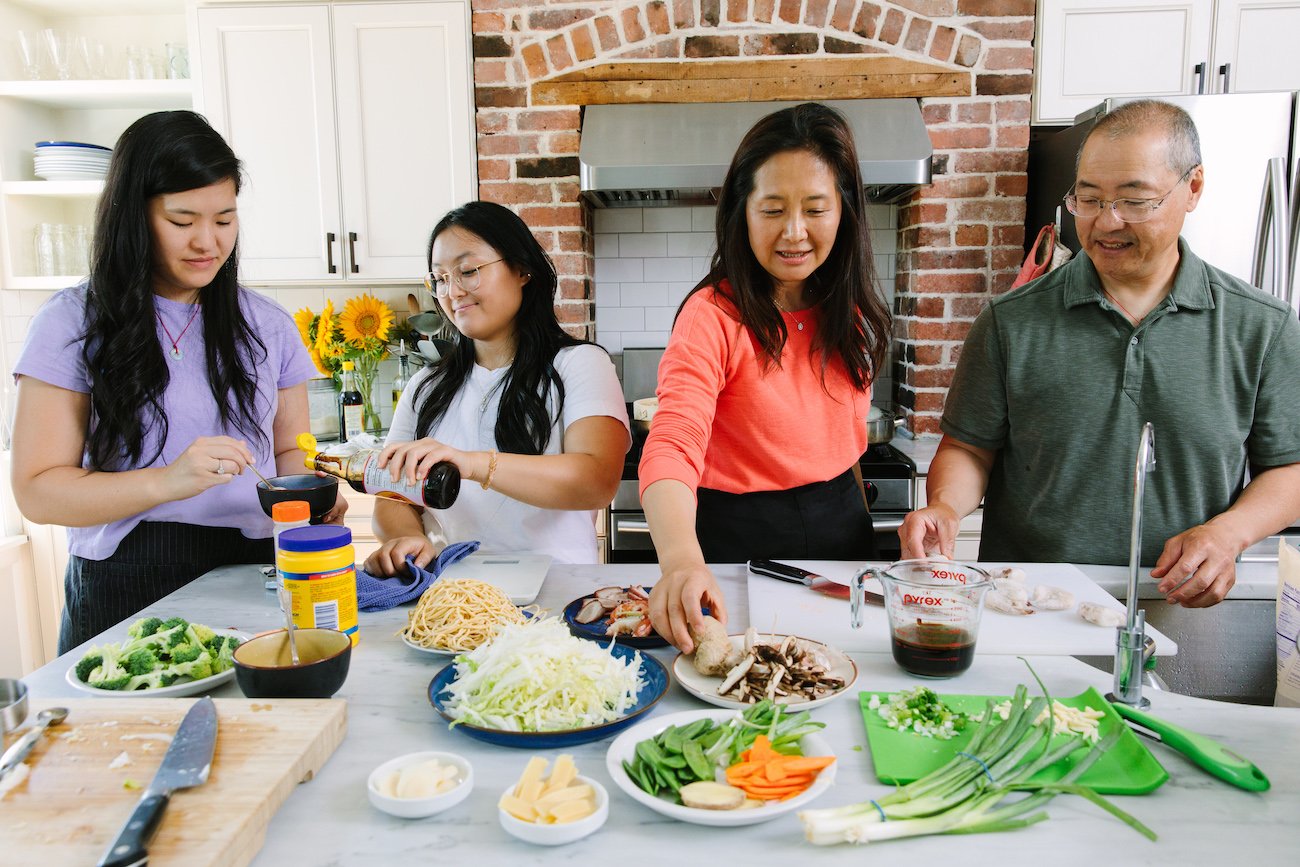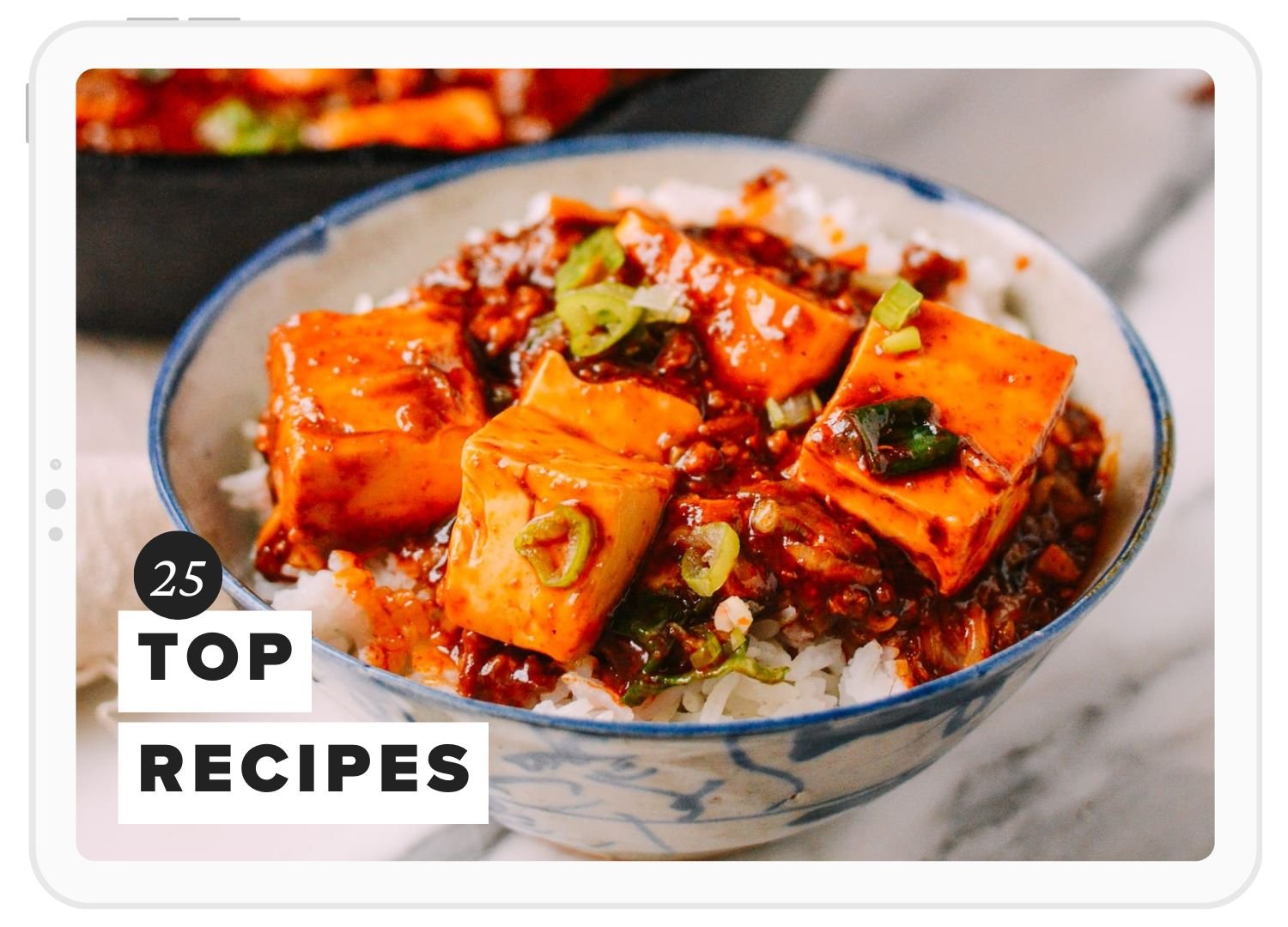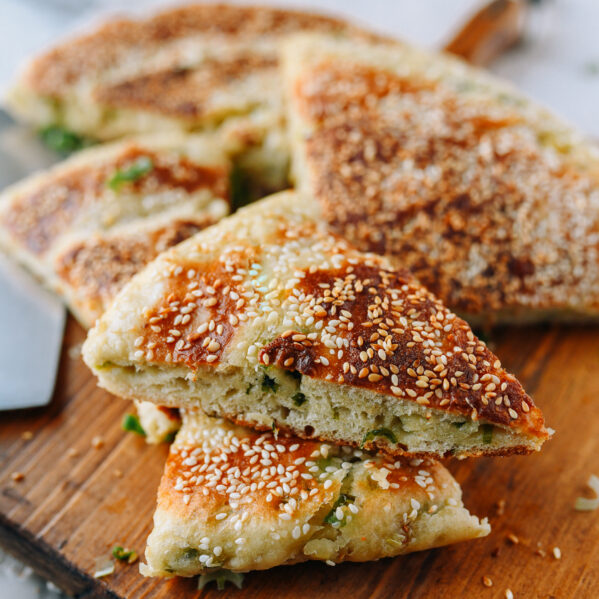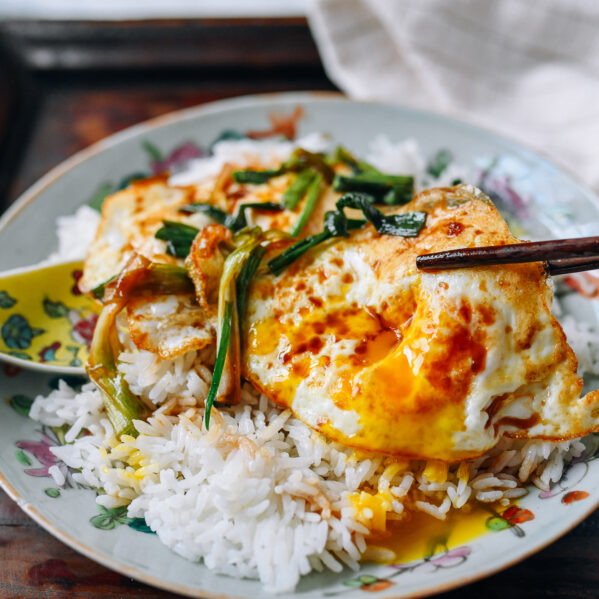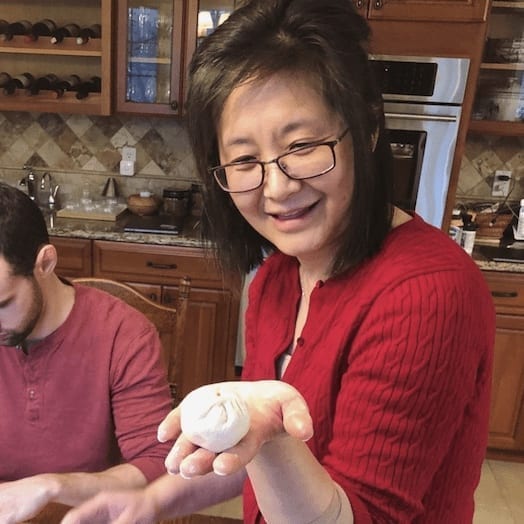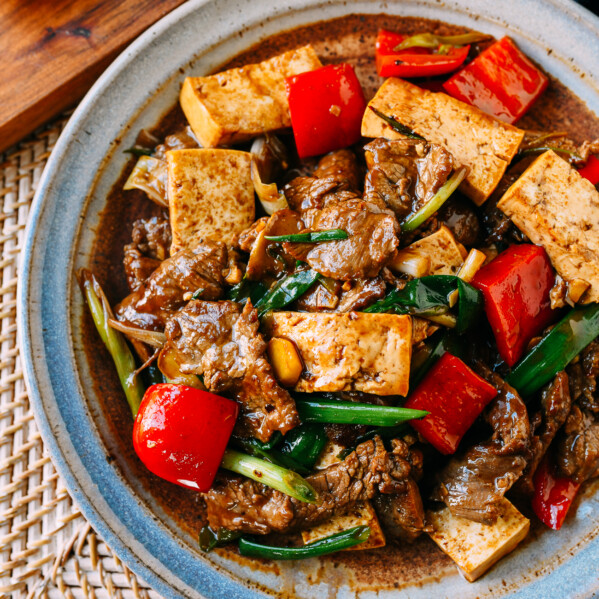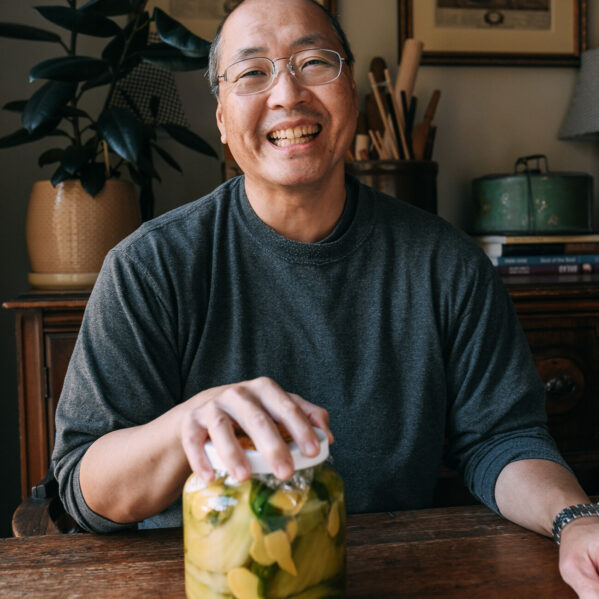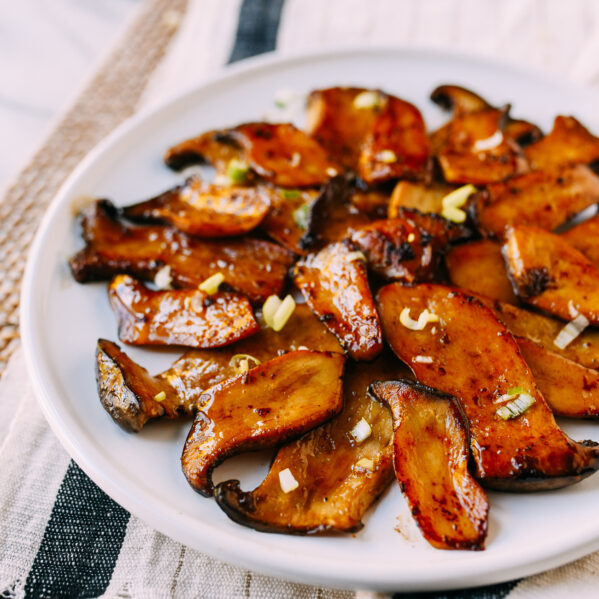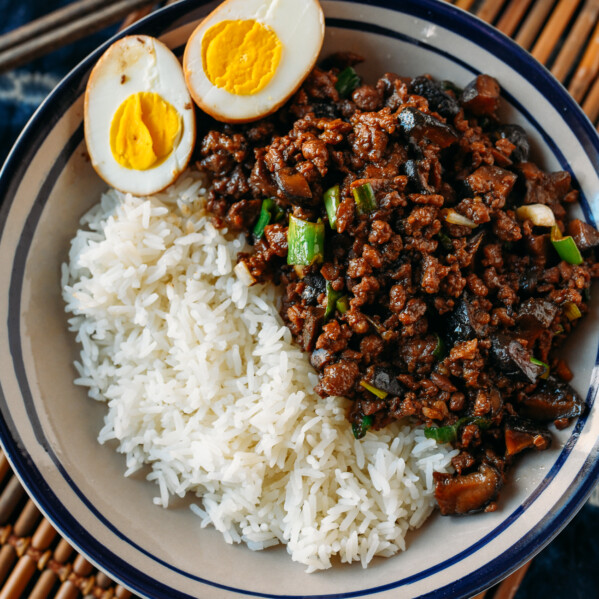
What Are Rice Cakes?
But first, what exactly are rice cakes? Rice cakes, or niángāo (年糕), originated in China, and there are many different types. They can be made with either rice flour or glutinous rice flour and formed into different shapes. They can be sweetened and served as a dessert, or used in savory dishes. Rice cakes are usually served around the lunar new year, because the word niángāo in Chinese translates to “nián” (年), which means “year,” and “gāo” (糕), which means “cake.” Gāo is ALSO is a homonym for the word “高,” which means “tall” or “high.” The symbolism of eating rice cakes, therefore, is reaching higher levels of prosperity with each new year. The type of rice cakes I’m cooking with today are white and shaped into flat ovals: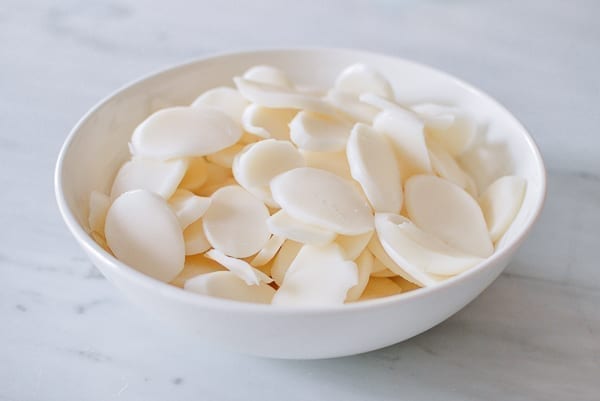 They are chewy in texture, almost like a kind of noodle. In our family, we like to call them “Chinese gnocchi.” They’re also extremely versatile, and can be added to a stir-fry or soup to make a complete meal.
They are chewy in texture, almost like a kind of noodle. In our family, we like to call them “Chinese gnocchi.” They’re also extremely versatile, and can be added to a stir-fry or soup to make a complete meal.
The Obsession with Rice Cakes in Ningbo, China
The people of Ningbo are crazy about rice cakes. In fact, you can pretty much credit all your favorite Chinese rice cake dishes to this city in Zhejiang Province. We’ve posted four savory Chinese rice cake recipes so far, all stir-fries:- Stir-fried Sticky Rice Cakes
- Shanghai Rice Cakes with Shepherd’s Purse
- Spicy Stir-fried Rice Cakes
- Steak and Scallion Rice Cake Stir-fry
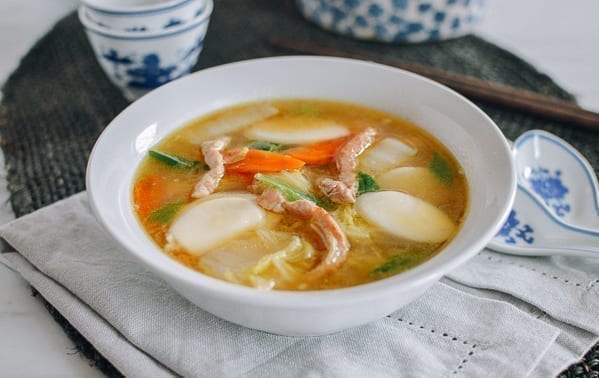 Though I consider myself Shanghaiese, my ancestors are from Ningbo. Shanghai is kind of like New York City––everyone there is a migrant or the child of a migrant. In Shanghai, when we’d hear people ask about each other’s ancestral homes in conversation, we’d most often hear answers like Ningbo, Suzhou, Huzhou, Shaoxing, and Wuxi. In my case, my paternal great-grandparents were from Ningbo.
So how much do Ningbo people love their rice cakes? Well, making rice cakes from scratch is a family affair around Chinese New Year, and people give stacks of rice cake bars as gifts. Rice cake soups and stir-fries are served as daily meals year-round as well as on special occasions.
Growing up, I remember roasting rice cakes over a coal burner until the edges were puffed up and slightly golden brown. What a treat that was! There were also many bars of rice cakes soaked in water throughout the winter months for a quick meal.
This rice cake soup recipe is so delicious, quick, and easy (simple enough for mid-week meals), I know your whole family will love it.
Though I consider myself Shanghaiese, my ancestors are from Ningbo. Shanghai is kind of like New York City––everyone there is a migrant or the child of a migrant. In Shanghai, when we’d hear people ask about each other’s ancestral homes in conversation, we’d most often hear answers like Ningbo, Suzhou, Huzhou, Shaoxing, and Wuxi. In my case, my paternal great-grandparents were from Ningbo.
So how much do Ningbo people love their rice cakes? Well, making rice cakes from scratch is a family affair around Chinese New Year, and people give stacks of rice cake bars as gifts. Rice cake soups and stir-fries are served as daily meals year-round as well as on special occasions.
Growing up, I remember roasting rice cakes over a coal burner until the edges were puffed up and slightly golden brown. What a treat that was! There were also many bars of rice cakes soaked in water throughout the winter months for a quick meal.
This rice cake soup recipe is so delicious, quick, and easy (simple enough for mid-week meals), I know your whole family will love it.
Chinese Rice Cake Soup: Recipe Instructions
Combine the pork (or chicken) with the Shaoxing wine, light soy sauce, sesame oil, white pepper, cornstarch, and water. Marinate for 15 to 20 minutes. While it’s marinating, prepare your other ingredients.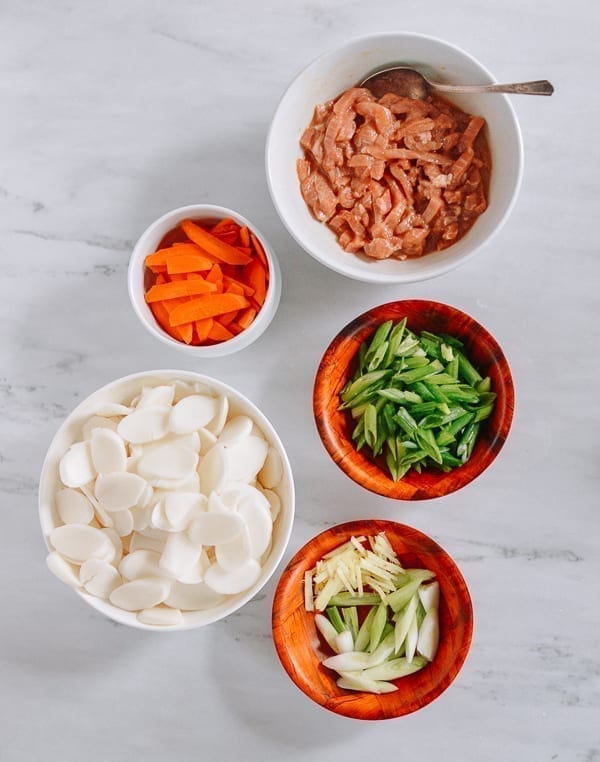 Make sure to slice your carrots thinly so they cook through in the soup:
Make sure to slice your carrots thinly so they cook through in the soup:
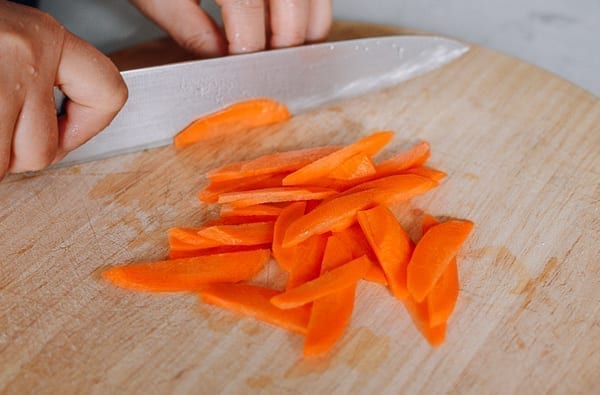 Break down the napa cabbage by ripping off individual leaves. Slice the stems part of the leaf into 1/2 inch pieces, and when you reach the “leafy” section of each leaf, cut into 1-inch pieces.
Break down the napa cabbage by ripping off individual leaves. Slice the stems part of the leaf into 1/2 inch pieces, and when you reach the “leafy” section of each leaf, cut into 1-inch pieces.
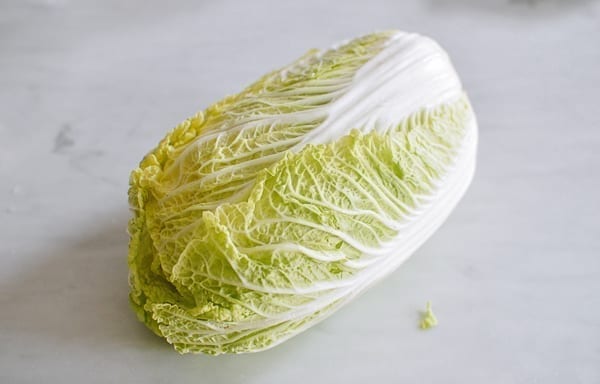
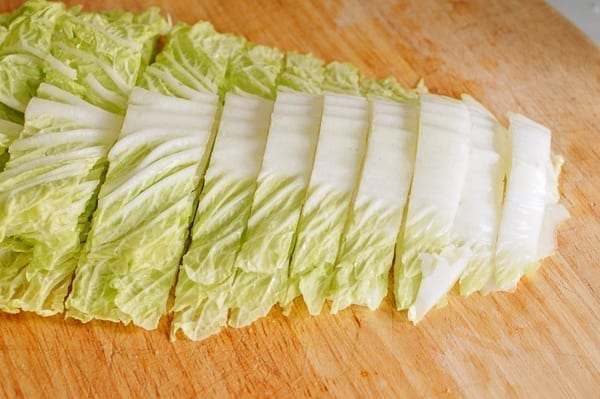 Preheat your wok until it starts to smoke lightly. Over high heat, add 2 tablespoons oil, and stir-fry the pork until browned. Remove the pork from the wok and set aside.
Preheat your wok until it starts to smoke lightly. Over high heat, add 2 tablespoons oil, and stir-fry the pork until browned. Remove the pork from the wok and set aside.
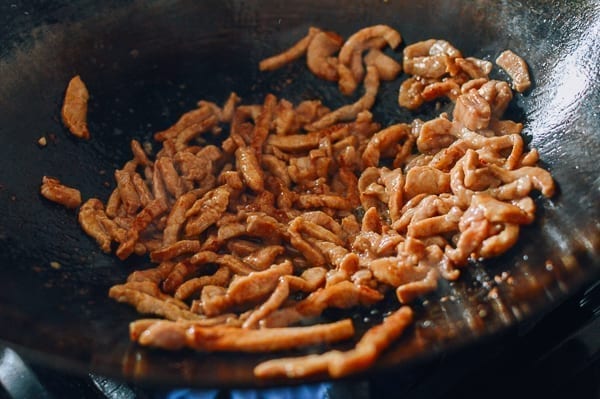 Reduce the heat to medium, and add 2 more tablespoons oil to the wok, along with the ginger and the white parts of the scallions.
Reduce the heat to medium, and add 2 more tablespoons oil to the wok, along with the ginger and the white parts of the scallions.
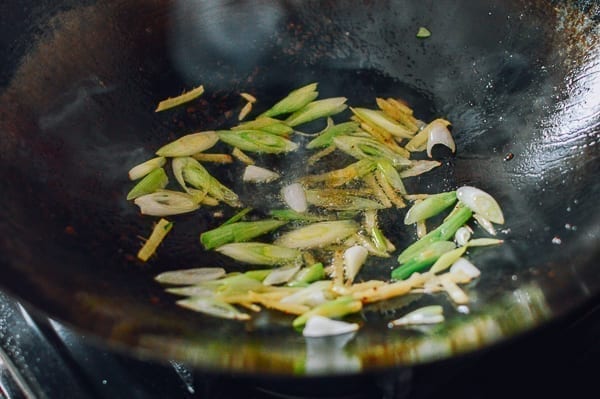 Cook for 1 minute and add the carrots.
Cook for 1 minute and add the carrots.
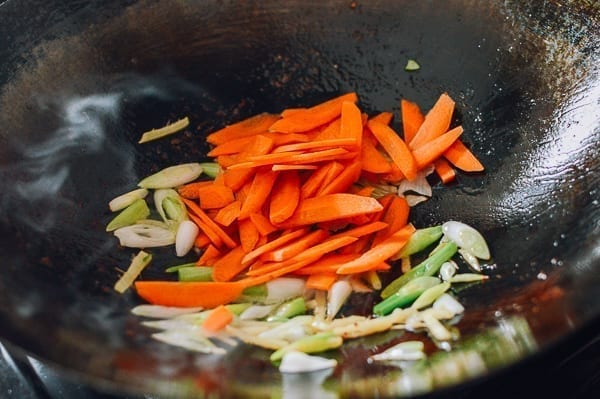 Cook for another minute and add the napa cabbage. You can see the wok we used was barely big enough for the task. Make sure you use a large enough wok or pot!
Cook for another minute and add the napa cabbage. You can see the wok we used was barely big enough for the task. Make sure you use a large enough wok or pot!
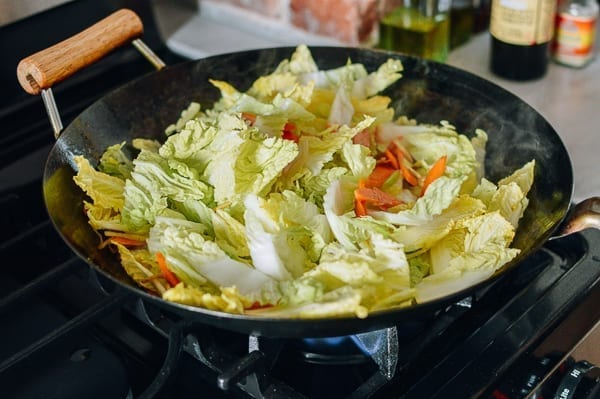 Stir fry everything together for a few minutes until the napa cabbage leaves are wilted.
Stir fry everything together for a few minutes until the napa cabbage leaves are wilted.
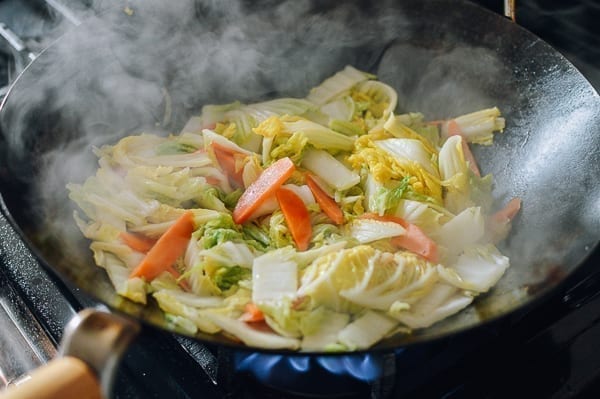 Add 4 cups low sodium chicken stock and 4 cups water. Bring everything to a boil, then lower the heat and simmer for 5 minutes, until the thick stems of the napa cabbage are tender.
Add 4 cups low sodium chicken stock and 4 cups water. Bring everything to a boil, then lower the heat and simmer for 5 minutes, until the thick stems of the napa cabbage are tender.
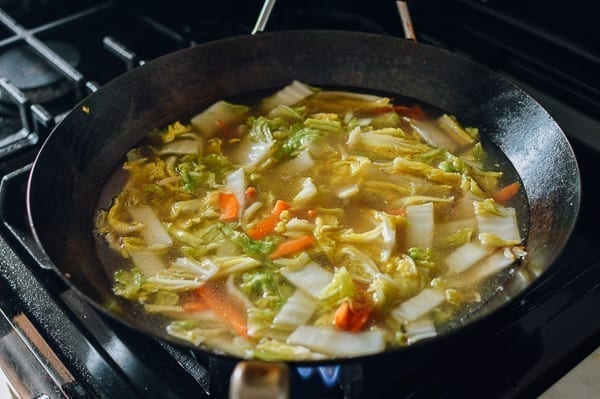 Add salt to taste, ½ teaspoon white pepper, 1 teaspoon sesame oil, and 1 tablespoon light soy sauce.
Stir in the cooked pork…
Add salt to taste, ½ teaspoon white pepper, 1 teaspoon sesame oil, and 1 tablespoon light soy sauce.
Stir in the cooked pork…
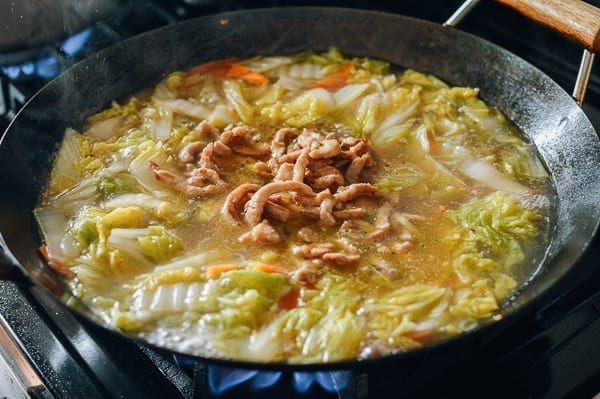 And sprinkle the rice cakes over the surface of the soup, along with green parts of the scallions. The rice cakes should be resting on top of the soup so they don’t sink into it and stick to the bottom of the wok/pot. Cover and cook for another minute, or as long as it takes to cook the rice cakes through (please see the Recipe Notes if you are using dried rice cakes).
And sprinkle the rice cakes over the surface of the soup, along with green parts of the scallions. The rice cakes should be resting on top of the soup so they don’t sink into it and stick to the bottom of the wok/pot. Cover and cook for another minute, or as long as it takes to cook the rice cakes through (please see the Recipe Notes if you are using dried rice cakes).
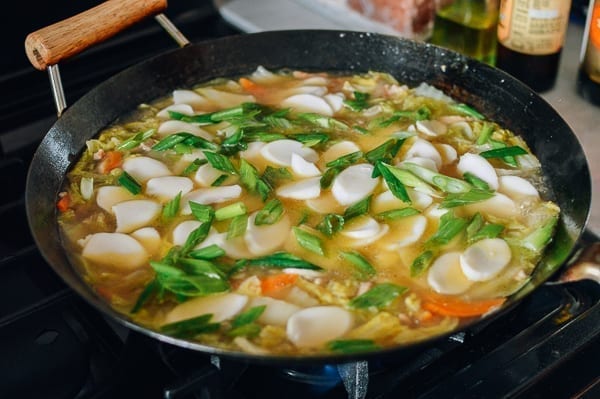 Salt to taste again and serve!
Salt to taste again and serve!
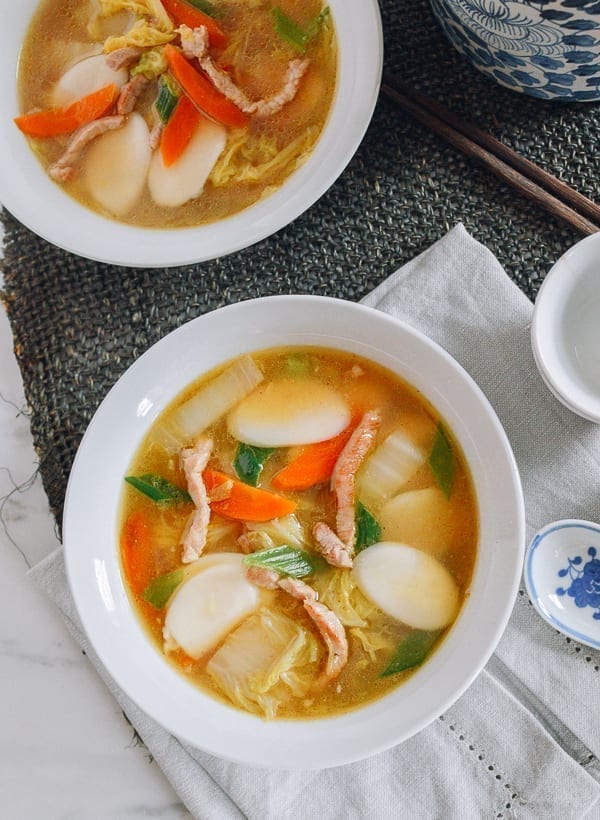
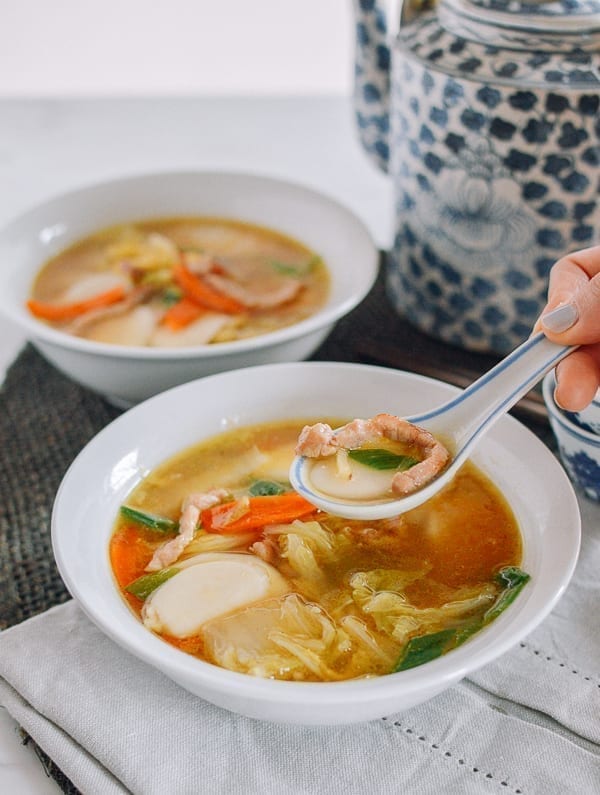
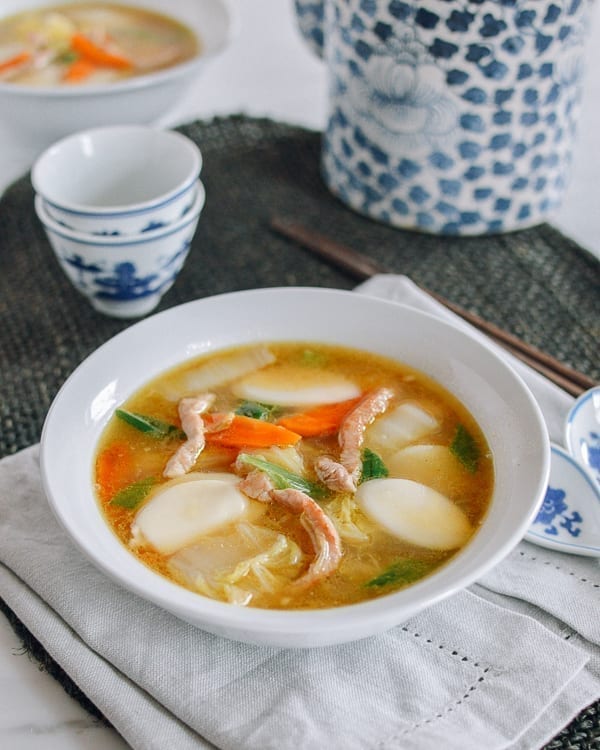
Recipe
Chinese Rice Cake Soup
This Chinese rice cake soup is delicious and comforting, and very easy to make! Our recipe honors the tradition of cooking with rice cakes in Ningbo, China.
Serves: 6
Ingredients
For the meat & marinade:
- 8 ounces lean pork or chicken (cut into small, thin strips)
- 2 teaspoons Shaoxing wine
- 1 tablespoon light soy sauce
- 1/2 teaspoon sesame oil
- 1/4 teaspoon white pepper
- 2 teaspoons cornstarch
- 1 teaspoon water
To assemble the soup:
- 4 tablespoons vegetable oil (divided)
- 4 slices ginger (julienned)
- 3 scallions (thinly sliced on an angle, white and green parts separated)
- 1 small carrot (thinly sliced)
- 1 1/4 pounds napa cabbage (stems cut into ½-inch pieces and leaves cut into 1-inch pieces)
- 4 cups low sodium chicken stock
- 4 cups water
- 1/2 teaspoon white pepper
- 1 teaspoon sesame oil
- 1 tablespoon light soy sauce
- 1 pound rice cakes (oval-shaped slices preferred)
Instructions
- Combine the pork (or chicken) with the Shaoxing wine, light soy sauce, sesame oil, white pepper, cornstarch, and water. Marinate for 15 to 20 minutes.
- Preheat your wok until it starts to smoke lightly. Over high heat, add 2 tablespoons oil, and stir-fry the pork until browned. Remove the pork from the wok and set aside.
- Reduce the heat to medium, and add 2 more tablespoons oil to the wok, along with the ginger and the white parts of the scallions. Cook for 1 minute and add the carrots. Cook for another minute and add the napa cabbage. Stir fry everything together for a few minutes until the napa cabbage leaves are wilted.
- Add 4 cups low sodium chicken stock and 4 cups water. Bring everything to a boil, then lower the heat and simmer for 5 minutes, until the thick stems of the napa cabbage are tender.
- Add salt to taste, ½ teaspoon white pepper, 1 teaspoon sesame oil, and 1 tablespoon light soy sauce.
- Stir in the cooked pork, and sprinkle the rice cakes over the surface of the soup, along with green parts of the scallions. The rice cakes should be resting on top of the soup so they don’t sink into it and stick to the bottom of the wok/pot. Cover and cook for another minute, or as long as it takes to cook the rice cakes through (please see the Recipe Notes if you are using dried rice cakes). Salt to taste again and serve!
Tips & Notes:
Since this recipe requires 8 cups of liquid, keep in mind you’ll need a large wok. If your wok isn’t big enough to accommodate the recipe, you can make it in a large, thick-bottomed pot.
The cooking time for rice cakes can vary based on brand, whether the rice cakes were fresh, frozen, or dried to begin with, and how thick or thin they were cut. Cooking time can be anywhere from 1-10 minutes. Fresh rice cakes cook in a minute or two. Frozen rice cakes can be thawed beforehand or thrown into the dish frozen, though they may take an additional couple minutes. Dried rice cakes should be soaked overnight first and may also take a little longer to cook.
Nutrition Facts
Calories: 368kcal (18%) Carbohydrates: 46g (15%) Protein: 17g (34%) Fat: 14g (22%) Saturated Fat: 9g (45%) Monounsaturated Fat: 1g Trans Fat: 1g Cholesterol: 24mg (8%) Sodium: 482mg (20%) Potassium: 563mg (16%) Fiber: 2g (8%) Sugar: 2g (2%) Vitamin A: 2059IU (41%) Vitamin C: 27mg (33%) Calcium: 94mg (9%) Iron: 2mg (11%)





